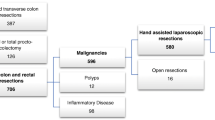Abstract
Background
Laparoscopically assisted colon resection has evolved to be a viable option for the treatment of colorectal cancer. This study evaluates the efficacy of hand-assisted laparascopic surgery (HALS) as compared with totally laparoscopic surgery (LAP) for segmental oncologic colon resection with regard to lymph node harvest, operative times, intraoperative blood loss, pedicle length, incision length, and length of hospital stay in an attempt to help delineate the role of each in the treatment of colorectal cancer.
Methods
Patient charts were retrospectively reviewed to acquire data for this evaluation. Between June 2001 and July 2005, 40 patients underwent elective oncologic segmental colon resection (22 HALS and 18 LAP). The main outcome measures included lymph node harvest, operative times, intraoperative blood loss, pedicle length, incision length, and length of hospital stay.
Results
The two groups were comparable in terms of demographics. The tumor margins were clear in all the patients. The HALS resection resulted in a significantly higher lymph node yield than the LAP resection (HALS: 16 nodes; range, 5–35 nodes vs LAP: 8 nodes; range, 5–22 nodes; p < 0.05) and significantly shorter operative times (HALS: 120 min; range, 78–181 min vs LAP: 156 min; range, 74–300 min; p < 0.05). Both groups were comparable with regard to length of hospital stay, pedicle length, and intraoperative blood loss. However, the LAP group yielded a significantly smaller incision for specimen extraction (LAP: 7 cm; range, 6–8 cm vs HALS: 5.5 cm; range, 5–7 cm; p < 0.05).
Conclusion
The findings suggest that hand-assisted laparoscopic oncologic segmental colonic resection is associated with shorter operative times, more lymph nodes harvested, and equivalent hospital stays, pedicle lengths, and intraoperative blood losses as compared with the totally laparoscopic approach. The totally laparoscopic technique was completed with a smaller incision. However, this less than 1 cm reduction in incision length has doubtful clinical significance.

Similar content being viewed by others
References
Berends FJ, Kazemier G, Bonjer HJ, Lange JF (1994) Subcutaneous metastases after laparoscopic colectomy. Lancet 344:58
Braga M, Vignali A, Zuliani W, Frasson M, Di Serio C, Di Carlo V (2002) Laparoscopic versus open colorectal surgery: cost-benefit analysis in a singlecenter randomized trial. Ann Surg 242:890–895, discussion 895–896
Clinical Outcomes of Surgical Therapy Study Group (2004) A comparison of laparoscopically assisted and open colectomy for colon cancer. N Engl J Med 350:2050–2059
Compton CC, Fielding LP, Burgart LJ, Conley B, Cooper HS, Hamilton SR, Hammond ME, Henson DE, Hutter RV, Nagle RB, Nielsen ML, Sargent DJ, Taylor CR, Welton M, Willett C (2000) Prognostic factors in colorectal cancer. College of American Pathologists Consensus Statement 1999. Arch Pathol Lab Med 124:979–994
Fine AP, Lanasa S, Gannon MP, Cline CW, James R (1995) Laparoscopic colon surgery: report of a series. Am Surg 61:412–416
Franklin ME, Kazantsev GB, Abrego D, Diaz-E JA, Balli J, Glass JL (2000) Laparoscopic surgery for stage III colon cancer: long-term follow-up. Surg Endosc 14:612–616
Goldstein NS (2002) Lymph node recoveries from 2,427 pT3 colorectal resection specimens spanning 45 years: recommendations for a minimum number of recovered lymph nodes based on predictive probabilities. Am J Surg Pathol 26:179–189
HALS Study Group (2000) Hand-assisted laparoscopic surgery vs standard laparoscopic surgery for colorectal disease: a prospective randomized trial. HALS Study Group. Surg Endosc 14:896–901
Lacy AM, Delgado S, Garcia-Valdecasas JC, Castells A, Pique JM, Grande L, Fuster J, Targarona EM, Pera M, Visa J (1998) Port-site metastases and recurrence after laparoscopic colectomy: a randomized trial. Surg Endosc 12:1039–1042
Le Voyer TE, Sigurdson ER, Hanlon AL, Mayer RJ, Macdonald JS, Catalano PJ, Haller DG (2003) Colon cancer survival is associated with increasing number of lymph nodes analyzed: a secondary survey of intergroup trial INT-0089. J Clin Oncol 21:2912–2919
Nakajima K, Lee SW, Cocilovo C, Foglia C, Sonoda T, Milsom JW (2004) Laparoscopic total colectomy: hand-assisted vs standard technique. Surg Endosc 18:582–586; Epub 2004 Mar 19
Nelson H, Petrelli N, Carlin A, Couture J, Fleshman J, Guillem J, Miedema B, Ota D, Sargent D (2001) National Cancer Institute Expert Panel. Guidelines 2000 for colon and rectal cancer surgery. J Natl Cancer Inst 93:583–596
Phillips EH, Franklin M, Carroll BJ, Fallas MJ, Ramos R, Rosenthal D (1992) Laparoscopic colectomy. Ann Surg 216:703–707
Puente I, Sosa JL, Sleeman D, Desai U, Tranakas N, Hartmann R (1994) Laparoscopic assisted colorectal surgery. J Laparoendosc Surg 4:1–7
Reilly WT, Nelson H, Schroeder G, Wieand HS, Bolton J, O’Connell MJ (1996) Wound recurrence following conventional treatment of colorectal cancer: a rare but perhaps underestimated problem. Dis Colon Rectum 39:200–207
Schirmer BD (1996) Laparoscopic colon resection. Surg Clin North Am 76:571–583
Senagore AJ, Delaney CP, Madboulay K, Brady KM, Fazio VW (2003) Laparoscopic colectomy in obese and nonobese patients. J Gastrointest Surg 7:558–561
Targarona EM, Gracia E, Garriga J, Martinez-Bru C, Cortes M, Boluda R, Lerma L, Trias M (2002) Prospective randomized trial comparing conventional laparoscopic colectomy with hand-assisted laparoscopic colectomy: applicability, immediate clinical outcome, inflammatory response, and cost. Surg Endosc 16:234–239; Epub 2001 Oct 13
Tekkis PP, Senagore AJ, Delaney CP, Fazio VW (2005) Evaluation of the learning curve in laparoscopic colorectal surgery: comparison of right-sided and left-sided resections. Ann Surg 242:83–91
The Southern Surgeons Club (1991) A prospective analysis of 1,518 laparoscopic cholecystectomies. The Southern Surgeons Club. N Engl J Med 324:1073–1078
Author information
Authors and Affiliations
Corresponding author
Rights and permissions
About this article
Cite this article
Ringley, C., Lee, Y.K., Iqbal, A. et al. Comparison of conventional laparoscopic and hand-assisted oncologic segmental colonic resection. Surg Endosc 21, 2137–2141 (2007). https://doi.org/10.1007/s00464-007-9401-y
Received:
Revised:
Accepted:
Published:
Issue Date:
DOI: https://doi.org/10.1007/s00464-007-9401-y




